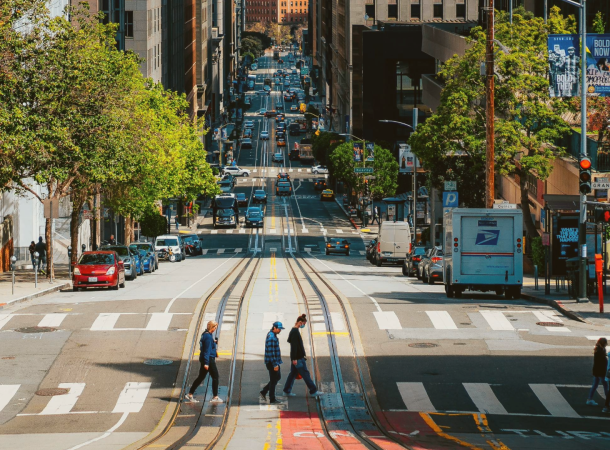
Most Liberal States in the US in 2024
The US paints a political spectrum as vast as the country’s prairies and as distinct as its
mountain peaks. Yet, amid this tableau, certain ‘blue states’ stand out for their liberal leanings.
These states — California, Massachusetts, and New York to name a few — are hubs where social equality, climate consciousness, and innovation find fertile ground to bloom, coloring the nation with the hues of progress and optimism.
Let’s embark on a journey to better understand these unique political landscapes, as they offer a compelling glimpse into America’s dynamic scenery of liberalism.
Liberalism in the US
In the vast political canvas of the United States, different states are found colored in various hues of ‘blue’ and ‘red’.
Blue states are repositories of liberal culture, whereas in contrast, red states are of conservatism. Despite the higher count of red states, the densely populated blue ones often sway major political indices such as the electoral college and congressional representation.
States like Pennsylvania, Virginia, Wisconsin, among others, offer a different narrative. These ‘swing states’, oscillating between Democratic and Republican allegiances during elections, become hotspots for intensive campaigning.
Furthermore, the degree of liberalism isn’t uniform across blue states. It varies from place to place, like Hawaii, California, New York, Oregon, and others. It’s important to note that liberalism also thrives in cities, often marked by diversity and a welcoming attitude towards LGBTQ+ communities. San Francisco, Washington, DC, and Seattle lead the pack, all nestled within the blue states.
Naturally, a state’s political leaning isn’t cast in stone: factors like immigration, minority empowerment, and tax policies can shift a state along the political spectrum. For instance, New York, once a conservative stronghold, stands as a testament to this transformation, now wearing its progressive badge proudly.
20 Most Liberal States in the US
The following table exhibits the 20 most liberal states in the US based on the data from 2019.
State | % Liberal | % Conservative | % Moderate | % Liberal Advantage |
Massachusetts | 35% | 21% | 38% | 14% |
Hawaii | 28% | 22% | 45% | 6% |
Rhode Island | 25% | 29% | 40% | -4% |
California | 29% | 29% | 36% | 0% |
New York | 30% | 27% | 35% | 3% |
Vermont | 32% | 28% | 36% | 4% |
Maryland | 28% | 29% | 39% | -1% |
New Jersey | 27% | 29% | 37% | -2% |
Connecticut | 27% | 30% | 38% | -3% |
Oregon | 28% | 32% | 35% | -4% |
Colorado | 26% | 33% | 37% | -7% |
Nevada | 23% | 33% | 38% | -10% |
New Mexico | 20% | 38% | 37% | -18% |
Delaware | 24% | 29% | 43% | -5% |
Illinois | 27% | 31% | 36% | -4% |
Washington | 31% | 28% | 37% | 3% |
Maine | 33% | 35% | 29% | -2% |
Minnesota | 25% | 32% | 37% | -7% |
Virginia | 24% | 33% | 37% | -9% |
Alaska | 17% | 40% | 38% | -23% |
Further Analysis of the Most Liberal States
Massachusetts, known for its liberal values, stands as the most liberal state in the United States. A significant 35% of voters in Massachusetts identify as liberal, enjoying a 14-point liberal advantage over conservatives who account for 21% of voters. The state’s largest group consists of moderates, making up 38% of the voting population. Massachusetts has historically leaned Democratic, with 60% of voters casting their ballots for the Democratic candidate in the 2016 presidential election. Notably, the state has produced renowned politicians like Elizabeth Warren, Michael Dukakis, Jill Stein, and the Kennedy family. Its urban areas and highly educated population contribute to fostering a liberal environment.
Hawaii claims the second spot as the country’s second-most liberal state. With 28% of voters identifying as liberal and 22% as conservative, Hawaii maintains a liberal advantage of 6 points, the second-highest in the nation. Moderates form the largest group in the state, representing 45% of voters, the highest percentage across all states. In the 2016 presidential election, an overwhelming 62.2% of Hawaiian voters sided with the Democratic candidate.
Rhode Island, the smallest state in the country, holds the third-most liberal position. In Rhode Island, 25% of residents identify as liberal, 29% as conservative, and 40% as moderate. The state has shown a strong inclination toward Democratic candidates, having voted for a Republican presidential candidate only twice since 1960.
California secures the fourth place among the most liberal states, with 29% of voters identifying as liberal and an equal percentage as conservative, resulting in a liberal advantage of zero points. Moderates account for 36% of the state’s voters. Given its substantial number of electoral votes, California holds considerable influence in national elections. In the 2016 presidential election, Democrats enjoyed a 30% lead over Republicans, with 61.5% of Californian voters casting their ballots for the Democratic candidate.
New York follows closely as the fifth-most liberal state in the U.S. In New York, 30% of voters identify as liberal, granting a 3-point liberal advantage over the 27% of conservative voters. Geographically, the state displays a split between more conservative upstate areas and liberal metropolitan areas. During the 2016 presidential election, 59% of New York voters leaned Democratic.
Vermont ranks sixth among the most liberal states, boasting 32% of voters who identify as liberal. With 28% identifying as conservative, Vermont holds a liberal advantage of 4 points, the third-highest in the country. In the 2016 election, 56.3% of Vermont voters supported the Democratic candidate, while 30.3% voted Republican. Barack Obama notably won Vermont by a significant margin of 35.6 percentage points in 2012.
Maryland showcases 28% of voters identifying as liberal, with 29% identifying as conservative, resulting in a slight liberal advantage of -1 point. The largest group of voters in Maryland consists of moderates, accounting for 39% of the population. The state’s liberal base is concentrated in the Washington D.C. metro area and Baltimore. In the 2016 presidential election, 60.3% of Maryland voters leaned Democratic. Maryland has implemented progressive policies such as legalizing gay marriage, enacting strict gun restrictions, and imposing tax increases.
New Jersey, despite having a negative liberal advantage of -2 points, sees many moderate voters leaning toward progressive social policies. Consequently, the state has not voted for a Republican presidential candidate since 1988.
Connecticut, akin to New Jersey, showcases a similar dynamic with 27% of residents identifying as liberal, 30% as conservative, and a sizable portion of the 38% of self-identified moderates leaning more liberal than conservative. The state attracts highly educated citizens similar to its neighboring state, Massachusetts.
Oregon secures the tenth spot as the country’s tenth-most liberal state. With 28% of voters identifying as liberal, Oregon maintains a liberal advantage of -4 points due to 32% identifying as conservative. Moderates make up 35% of voters. 50.1% of Oregonian voters leaned Democratic in the 2016 presidential election, while 39.1% voted Republican. Eugene and Portland emerged as the most Democratic regions within the state.
Common Characteristics of Liberal States
🗽 Progressive Policies: Liberal states often adopt progressive policies such as legalized gay marriage, stricter gun control, and environmental protection.
🏙️ Urban Areas: Liberal states are more likely to have vibrant and diverse urban areas, offering cultural, educational, and economic opportunities.
📚 Highly Educated Population: Liberal states tend to attract and cultivate a highly educated population, fostering innovation and intellectual growth.
🌍 Environmental Consciousness: Liberal states often prioritize environmental sustainability and conservation efforts.
🤝 Inclusivity and Diversity: Liberal states embrace inclusivity and diversity, promoting acceptance and equal rights for marginalized communities.
🗳️ Political Influence: Liberal states with larger populations or significant electoral votes can wield considerable political influence in national elections.
💡 Innovation and Technology: Liberal states often lead in technological advancements, research, and innovation across various sectors.
🌐 Global Perspective: Liberal states are more likely to have a global outlook, engaging in international relations and promoting diplomacy.
🎓 Access to Healthcare and Education: Liberal states tend to prioritize access to quality healthcare and education, striving for equitable opportunities for all residents.
💪 Social Safety Nets: Liberal states often have robust social safety net programs aimed at assisting vulnerable populations and reducing inequality.
Policies Adopted by Liberal States
- Legalized gay marriage
- Stricter gun control measures
- Environmental protection and sustainability initiatives
- Equal rights and anti-discrimination legislation
- Expansion of healthcare access and coverage
- Investments in renewable energy and clean technologies
- Support for affordable housing initiatives
- Advancement of progressive taxation systems
- Focus on criminal justice reform
- Implementation of social safety net programs
- Emphasis on public education funding and reforms
- Promotion of women’s reproductive rights
- Advocacy for immigrant rights and inclusive immigration policies
- Support for worker protection and minimum wage increases
- Push for police reform and accountability measures.
Most Liberal States: The Wrap-Up
In conclusion, liberal states pave the way for social change and equality with the progressive policies they employ. Their vibrant urban areas foster cultural diversity and provide abundant opportunities for personal and professional growth.
With highly educated populations, liberal states drive innovation, research, and technological advancements. They prioritize environmental sustainability and advocate for a global perspective, engaging in international relations, as well as providing access to quality healthcare and education, ensuring a brighter future for their residents.
FAQs
What are the most liberal states in the US?
The most liberal states in the US are those where a significant portion of the voting population identifies as liberal. These states embrace progressive policies, inclusivity, and social change. Massachusetts, Hawaii, California, Vermont, and New York are considered among the most liberal states. However, it's important to note that political ideology can vary within states, and recent years have shown shifts in voting patterns.
How many liberals are there in the most liberal states?
The number of liberals in the most liberal states can vary, but these states generally have a higher concentration of residents who identify as liberal compared to conservative states. For example, Massachusetts, with its liberal advantage of 14 points, has 35% of voters identifying as liberal, while Hawaii has 28% identifying as liberal with a 6-point liberal advantage.
Are liberal states always aligned with the Democratic Party?
Liberal states often lean towards the Democratic Party due to their progressive values and policy priorities. The Democratic Party has historically enjoyed strong support from liberal-leaning states, particularly in recent years. However, it's important to note that political dynamics can change over time, and there may be variations in voting patterns within these states.
Do conservative states exist in the US alongside liberal states?
Political ideology varies across the country, and there are states where a higher percentage of the voting population identifies as conservative. These conservative states often align more closely with the Republican Party and tend to prioritize different policy objectives compared to liberal states.
How have residents in the most liberal states voted in recent elections?
In recent years, residents in the most liberal states have generally leaned towards voting for Democratic candidates in national elections. However, it's important to note that voting patterns can change over time and vary among different regions within these states. Factors such as urban-rural divides and specific issues affecting local communities can influence election outcomes.
Have liberal states always voted for Democratic candidates?
Liberal states have shown a tendency to vote for Democratic candidates in presidential elections, but it's important to note that there have been exceptions. While these states often lean Democratic, individual elections can result in varied outcomes. For instance, some liberal states have voted for Republican candidates in the past, although it may be less common in recent years.
What are the most conservative states in the US?
Wyoming, North Dakota, and West Virginia are some of the most conservative states in the US, where Democratic voters are significantly outnumbered by their Republican counterparts.








